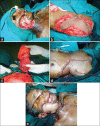Feasibility and Reliability of Microvascular Reconstruction in the Vessel-depleted Previously Operated Neck
- PMID: 32855923
- PMCID: PMC7433941
- DOI: 10.4103/ams.ams_201_19
Feasibility and Reliability of Microvascular Reconstruction in the Vessel-depleted Previously Operated Neck
Abstract
Background: Microvascular reconstruction of defects in the head and neck has always been a challenge in patients who have undergone previous neck dissection, owing to the prior resection of potential recipient blood vessels used for free flap perfusion.
Objective: The objective of the study is to evaluate the reliability and safety of free flap reconstruction in patients who have had previous neck dissection.
Materials and methods: Twenty-four free flaps were performed in 22 patients with a previous history of neck dissection for head-and-neck squamous cell carcinoma. These included patients who underwent salvage surgery for recurrent cancer as well as patients undergoing secondary reconstruction following previous oncological resections. Flap includes 12 radial forearm free flaps, 5 fibula flaps, 1 rectus abdominis flap, and 6 anterolateral thigh flaps.
Results: In cases with the previous history of selective neck dissection, recipient vessels on the ipsilateral/same side of the previously operated neck were used, while contralateral vessels were used in patients with a history of modified radical or radical neck dissection. Vein grafts were not necessary, except for one case. In our series, we did not have any flap loss or considerable increase in operative time.
Conclusions: Free flap reconstruction of head-and-neck defects is highly successful in patients with a history of previous neck dissection, despite a relative scarcity of recipient blood vessels. Careful planning and relying on flaps with a long vascular pedicle obviates the need to perform a suitable vein graft. In our present series, careful planning and the right choice of a free flap with a long vascular pedicle contributes to the absence of free flap failure. In our experience, previous neck dissection should not be considered as a contraindication to microvascular reconstruction of previously operated oncologic defects.
Keywords: Free flaps; microvascular surgery; neck dissection; recurrence; vessel compromised neck.
Copyright: © 2020 Annals of Maxillofacial Surgery.
Conflict of interest statement
There are no conflicts of interest.
Figures



Similar articles
-
Microvascular reconstruction after previous neck dissection.Arch Otolaryngol Head Neck Surg. 2002 Mar;128(3):328-31. doi: 10.1001/archotol.128.3.328. Arch Otolaryngol Head Neck Surg. 2002. PMID: 11886353
-
The role of the internal mammary vessels as recipient vessels in secondary and tertiary head and neck reconstruction.J Plast Reconstr Aesthet Surg. 2012 Jul;65(7):885-92. doi: 10.1016/j.bjps.2012.01.006. Epub 2012 Jan 27. J Plast Reconstr Aesthet Surg. 2012. PMID: 22284368
-
Microvascular Flap Reconstruction for Head and Neck Cancers in Previously Operated and/or Radiated Neck: Is It Safe?Ann Plast Surg. 2022 Jan 1;88(1):63-67. doi: 10.1097/SAP.0000000000002951. Ann Plast Surg. 2022. PMID: 34225312
-
Selection of recipient vessels in double free-flap reconstruction of composite head and neck defects.Plast Reconstr Surg. 2005 May;115(6):1553-61. doi: 10.1097/01.prs.0000160274.21680.6f. Plast Reconstr Surg. 2005. PMID: 15861058
-
Maxillary and Midface Reconstruction in Non-ideal Situations: Troubleshooting in a Difficult Surgical Field.Atlas Oral Maxillofac Surg Clin North Am. 2025 Mar;33(1):89-96. doi: 10.1016/j.cxom.2024.08.001. Epub 2024 Sep 13. Atlas Oral Maxillofac Surg Clin North Am. 2025. PMID: 39929562 Review. No abstract available.
Cited by
-
Head and Neck Reconstruction of the Vessel-Depleted Neck: A Systematic Review of the Literature.Ann Surg Oncol. 2021 May;28(5):2882-2895. doi: 10.1245/s10434-021-09590-y. Epub 2021 Feb 6. Ann Surg Oncol. 2021. PMID: 33550502
References
-
- Blackwell KE. Unsurpassed reliability of free flaps for head and neck reconstruction. Arch Otolaryngol Head Neck Surg. 1999;125:295–9. - PubMed
-
- Singh B, Cordeiro PG, Santamaria E, Shaha AR, Pfister DG, Shah JP. Factors associated with complications in microvascular reconstruction of head and neck defects. Plast Reconstr Surg. 1999;103:403–11. - PubMed
-
- Robbins KT. Classification of neck dissection: Current concepts and future considerations. Otolaryngol Clin North Am. 1998;31:639–55. - PubMed
-
- Daniel RK, Taylor GI. Distant transfer of an island flap by microvascular anastomoses. A clinical technique. Plast Reconstr Surg. 1973;52:111–7. - PubMed
-
- Davies DM. A world survey of anticoagulation practice in clinical microvascular surgery. Br J Plast Surg. 1982;35:96–9. - PubMed
LinkOut - more resources
Full Text Sources
